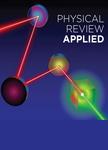版权所有:内蒙古大学图书馆 技术提供:维普资讯• 智图
内蒙古自治区呼和浩特市赛罕区大学西街235号 邮编: 010021

作者机构:Center for Advanced Quantum Studies and Department of Physics Beijing Normal University Beijing 100875 China Center for Quantum Computing Peng Cheng Laboratory Shenzhen 518005 China Center for Neurointelligence School of Medicine Chongqing University Chongqing 400044 China Center for Artificial Intelligence Peng Cheng Laboratory Shenzhen 518005 China Beijing Computational Science Research Center Beijing 100193 China Shenzhen Institute for Quantum Science and Engineering and Department of Physics Southern University of Science and Technology Shenzhen 518055 China
出 版 物:《Physical Review Applied》 (Phys. Rev. Appl.)
年 卷 期:2020年第14卷第4期
页 面:044060-044060页
核心收录:
基 金:Super Computing Center of Beijing Normal University National Natural Science Foundation of China, NSFC, (11734004, 31771146, 61774018) National Natural Science Foundation of China, NSFC Beijing Nova Program, (Z181100006218118) Beijing Nova Program Recruitment Program of Global Experts Fundamental Research Funds for the Central Universities, (2018EYT03, 2018STUD03, 2020CDJQY-A073) Fundamental Research Funds for the Central Universities National Safety Academic Fund, NSAF, (U1930402) National Safety Academic Fund, NSAF
主 题:Spintronics Synapses Vision Artificial neural networks Magnetic tunnel junctions Micromagnetic modeling
摘 要:Real-time tracking of high-speed objects in cognitive tasks is challenging in the present artificial intelligence techniques because the data processing and computation are time consuming, resulting in impeditive time delays. A brain-inspired continuous attractor neural network (CANN) can be used to track fast moving targets, where the time delays are intrinsically compensated if the dynamical synapses in the network have short-term plasticity. Here, we show that synapses with short-term depression can be realized by a magnetic tunnel junction, which perfectly reproduces the dynamics of the synaptic weight in a widely applied mathematical model. Then, these dynamical synapses are incorporated into one-dimensional and two-dimensional CANNs, which are demonstrated to have the ability to predict a moving object via micromagnetic simulations. This portable spintronics-based hardware for neuromorphic computing needs no training and is therefore very promising for the tracking technology of moving targets.